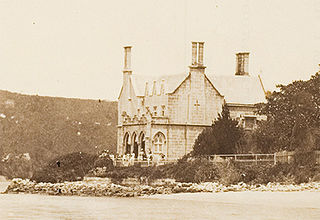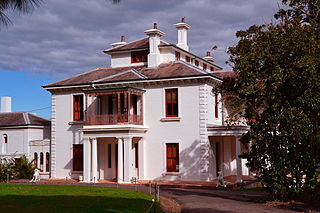
Glebe is an inner-western suburb of Sydney. Glebe is located 3 kilometres (1.9 mi) southwest of the Sydney central business district and is part of the local government area of the City of Sydney, in the Inner West region.
John Verge (1782–1861) was an English architect, builder, pioneer settler in the Colony of New South Wales, who migrated to Australia and pursued his career there. Verge was one of the earliest and the most important architect of the Greek Revival in Australia. He also brought more comprehensive range of Regency style than any contemporary architects. His design indicates the increasing of sophistication compared to previous architect's design.

Sir George Wigram Allen was an Australian politician and philanthropist. He was Speaker in the New South Wales Legislative Assembly 1875–1883. Allen was held in high esteem. As speaker he showed dignity, courtesy and ability; it was said of him: 'A man of calm judgment and much practical wisdom'.

St Scholastica's College is an independent Roman Catholic single-sex secondary day and boarding school for girls, located in Glebe Point, in Sydney, New South Wales, Australia.

Elizabeth Bay House is a heritage-listed Colonial Regency style house and now a museum and grotto, located at 7 Onslow Avenue in the inner eastern Sydney suburb of Elizabeth Bay in the City of Sydney local government area of New South Wales, Australia. The design of the house is attributed to John Verge and John Bibb and was built from 1835 to 1839 by James Hume. The grotto and retaining walls were designed by Verge and the carriage drive on Onslow Avenue was designed by Edward Deas Thomson and built from 1832 to 1835 by convict and free artisans under the direction of Verge. The property is owned by Sydney Living Museums, an agency of the Government of New South Wales. Known as "the finest house in the colony", Elizabeth Bay House was originally surrounded by a 22-hectare (54-acre) garden, and is now situated within a densely populated inner city suburb.

Bathurst Street is a street in the Sydney central business district in New South Wales, Australia. Bathurst Street runs for 650 metres (2,130 ft) in a west–east direction with traffic flowing in this direction only. It is situated in the southern portion of the central business district. The western terminus of Bathurst Street is at Harbour Street, Darling Harbour, with the eastern terminus at Elizabeth Street, adjacent to Hyde Park.

Abercrombie House was built in Bathurst, New South Wales, Australia in the 1870s by the Stewart family who were Bathurst pioneers. William Stewart came to Australia from England in 1825 as part of the colonisation of the penal colony (Australia). William was the Lieutenant Governor General of New South Wales; which meant he was hypothetically 2nd in command to running Australia. William was given land in Bathurst as a reward for doing his job well. William Stewart's eldest son James built Abercrombie House. The house is considered to be of extreme historical significance. It is listed on the National Trust Register. It is also on the New South Wales Heritage Register and the Australian Heritage Database which describes it as "an outstanding example of Victorian Tudor style architecture. It is built of granite with sandstone dressing to the quoins and window surrounds, and there are two storeys together with an attic floor. The building's most striking feature is its array of curvilinear parapeted gables topped by iron finials." The 50-acre (200,000 m2) land and house is currently owned by the Rex Henry Morgan Family. Since 1969 the Morgan family has made major restorations to the house. The House is currently occupied by Christopher Morgan and his family.
Rosebank College is an independent Roman Catholic comprehensive co-educational secondary day school in the Benedictine tradition, located in Five Dock, an inner-western suburb of Sydney, New South Wales, Australia.
The Congregation of the Sisters of the Good Samaritan, colloquially known as the "Good Sams", is a Roman Catholic congregation of religious women commenced by Bede Polding, OSB, Australia’s first Catholic bishop, in Sydney in 1857. The congregation was the first religious congregation to be founded in Australia. The sisters form an apostolic institute that follows the Rule of Saint Benedict. They take their name from the well-known gospel parable of the Good Samaritan.
Eleanor Marian Dundas Allen was a British writer, the author of the poem now known as "The Wind on the Downs" published in a small 63-page book of poems of the same name. Allen was born at Toxteth Park, Glebe, Sydney, the daughter of George Boyce Allen, a barrister, and Isabella Dundas Allen.

Carthona is a large Gothic Revival architecture style house situated at 5 Carthona Avenue, on a promontory of Darling Point, in Sydney, New South Wales, Australia. The mansion is listed by the New South Wales Heritage Council as a building of historical significance and is listed as being of local significance on the New South Wales Heritage Database.

Hon. George Allen (1800–1877) was an Australian colonial attorney and politician in New South Wales. He was the founder of Australia's oldest law firm, Allens.

Strickland House is a heritage-listed former residence and convalescent home and now functions, film studio, urban park and visitor attraction located at 52 Vaucluse Road, Vaucluse in the Municipality of Woollahra local government area of New South Wales, Australia. It was designed by John F. Hilly and built from 1830 to 1858 by William Wentworth. It is also known as Carrara; Strickland Convalescent Home for Women; Strickland House Hospital for the Aged. The property is owned by the Government of New South Wales. It was added to the New South Wales State Heritage Register on 2 April 1999 and on 21 March 1978 was listed on the Register of the National Estate.

Tranby is a heritage-listed former residence and now adult education centre located at 13 Mansfield Street in the inner western Sydney suburb of Glebe in the City of Sydney local government area of New South Wales, Australia. It was designed by A. L. & G. McCredie and built from 1858 to 1910. It is also known as Toxteth Cottage. The property is owned by Tranby Aboriginal Co-operative Ltd. It was added to the New South Wales State Heritage Register on 2 April 1999. Since 1958 the house and grounds have been the main campus of Tranby National Adult Indigenous Education and Training.
George Allen Mansfield was a prominent Australian architect of the nineteenth century who designed many iconic buildings in Sydney, New South Wales, Australia.

The Sze Yup Temple is a heritage-listed Chinese joss house and Taoist temple located at Victoria Road in the inner western Sydney suburb of Glebe in the City of Sydney local government area of New South Wales, Australia. It was built from 1898 to 1904. Properly the Sze Yup Kwan Ti Temple, it is also sometimes called the Sze Yup Temple & Joss House or Joss House and Chinese Temple. The property is owned by Trustees of the Sze Yup Temple. It was added to the New South Wales State Heritage Register on 2 April 1999. It is one of only four pre-World War I Chinese temples that remain active in Australia.

The Glebe Town Hall is a landmark civic building in Glebe, a suburb of Sydney, Australia. It stands at 160 St Johns Road and was built in 1880 in the Victorian Italianate style by architect Ambrose Thornley. The Town Hall was the seat of The Glebe Municipal Council from 1880 to 1948 when it became a community centre and hall run by the City of Sydney. After being transferred to the Municipality of Leichhardt in 1968, it was returned to the control of the City of Sydney following a boundary change on 8 May 2003.

The Rothwell Lodge and Factory is a heritage-listed historic site located at 24 Ferry Road in the inner western Sydney suburb of Glebe in the City of Sydney local government area of New South Wales, Australia. The property is privately owned. It was added to the New South Wales State Heritage Register on 2 April 1999.

Lyndhurst is a heritage-listed residence and former school, laundry, maternity hospital and industrial building located at 61 Darghan Street in the inner western Sydney suburb of Glebe in the City of Sydney local government area of New South Wales, Australia. It was designed by John Verge and built from 1833 to 1837. The property is owned by Historic Houses Trust of New South Wales. It was added to the New South Wales State Heritage Register on 2 April 1999.
Clara Jane McLaughlin (1856-1931), known by her religious name as Mary Berchmans, was an Australian nun who became superior general for the Sisters of the Good Samaritan.

























